
Related
Guests
- A.C. Thompsoninvestigative reporter whose latest article “Katrina’s Hidden Race War” appears in The Nation magazine. A.C. Thompson’s reporting on New Orleans was directed and underwritten by the Investigative Fund at the Nation Institute. ProPublica provided additional support, as did the Center for Investigative Reporting and New American Media.
- Donnell HerringtonNew Orleans resident who nearly died on Sept. 1, 2005, after he was shot by a white vigilante in Algiers Point.
In a shocking new report, The Nation magazine exposes how white vigilante groups patrolled the streets of New Orleans after Hurricane Katrina, shooting at least eleven African American men. Local police have never conducted investigations into the shootings. We speak to reporter A.C. Thompson and New Orleans resident Donnell Herrington, who nearly died after being shot by a white vigilante. [includes rush transcript]
Transcript
JUAN GONZALEZ: The Nation magazine has just published a major investigative report titled “Katrina’s Hidden Race War.” The article examines how a group of white vigilantes in the predominantly white New Orleans neighborhood of Algiers Point shot at least eleven African American men in the days after Hurricane Katrina. Local police have never conducted investigations into the shootings.
The author of the article, A.C. Thompson, will join us in a few minutes, but first we turn to a video produced by the Nation Institute and Hidden Driver. It is narrated by A.C. Thompson and features interviews with some of the victims of the vigilante violence.
A.C. THOMPSON: When Hurricane Katrina ripped into New Orleans, most people tried to flee. In one neighborhood, however, a band of fifteen to thirty people refused to evacuate. With the police department crippled, these people amassed weapons and began patrolling the streets. Before long, bullets began to fly.
Over the past eighteen months, I’ve interviewed figures on all sides of the gunfire: the gunmen, people who were shot and survived, and witnesses to the violence.
Severed from the rest of New Orleans by the river, Algiers Point is an insular, predominantly white neighborhood within the larger Algiers district, which is mostly African American. As word spread that Algiers Point was dry, desperate people fleeing flooded zip codes began headed towards the west bank.
MALIK RAHIM: I never thought that I would witness what I did during Katrina, you know, not in Algiers Point, not among some individuals that I classified as neighbors.
UNIDENTIFIED: We were blocking both ends of the street. It was during Hurricane, whatever, Katrina. They got — they’re doing looting. They’re looting the businesses right now, and we figure they’ll eventually get around to looting the houses.
A.C. THOMPSON: Fearing an influx of outsiders, the gunmen of Algiers Point barricaded their streets. Malik Rahim is one of a handful of blacks living in Algiers Point. In the days after Katrina, he says he was threatened at gunpoint by several white neighbors.
MALIK RAHIM: I couldn’t walk through Algiers Point.
A.C. THOMPSON: You couldn’t?
MALIK RAHIM: Oh, no. I could stay on my block. But if I were to turn that corner, I would have been in a firefight.
A.C. THOMPSON: Malik’s friend Reggie Bell was also confronted at gunpoint.
MALIK RAHIM: After they caught up with him, they told him to run. And if he would have ran, they was going to kill him. They were going to shoot him in the back. And he told them, he said, “Hey, man,” he said, “I live right here.” They told him to run.
A.C. THOMPSON: At the ferry terminal in Algiers Point, the National Guard established an evacuation zone and began busing flood victims to Houston. On September 1st, 2005, Donnell Herrington left his home and began walking toward the ferry terminal with his cousin, Marcel Alexander, and a friend, Chris Collins. To get to the evacuation zone, the trio had to walk through Algiers Point.
DONNELL HERRINGTON: You know, I was talking to my cousin and our friend, and I was telling them that, yeah, we’re finally about to get out of here. You know, I was talking. I was talking, because my cousin was on the side of me, on the right side, and I looked down at my arms and everything, and — because, you know, some of the shots hit me in my arm, my chest, my neck, my stomach. And, you know, I just saw blood everywhere.
MARCEL ALEXANDER: As I’m trying to pick him up, they shot us again, so I fell. And Donnell’s trying to get up, and we all were trying. We’re panicking now.
DONNELL HERRINGTON: And he was like hollering, like, “You OK? You alright?” And he was, you know — like I said, he was pretty hysterical, man. And when I — you know, when I saw the guy, when I actually recognized the guy with the shotgun, you know, it was like he was reloading or something.
MARCEL ALEXANDER: As I’m trying to pick him up, they coming towards us with the gun. It’s like probably like — at that time, it’s like probably two or three of them.
DONNELL HERRINGTON: And so, now I’m trying to get out of this guy — trying to get away from him, you know?
MARCEL ALEXANDER: Two of them coming my way and one of them coming at Donnell with — [inaudible] Donnell. And I’m running, me and Chris, running, running. They was like, “We’re gonna get you! We’re gonna get you, nigger!”
DONNELL HERRINGTON: I ran up into the corner. And they had these two guys in a car. They had these two white men in a car, a older white guy and another — you know, a younger white guy. And they had their shirts off. I can remember, you know? And they were like in a small pickup truck.
MARCEL ALEXANDER: We know y’all — what y’all was doing. We saw y’all.
A.C. THOMPSON: Marcel goes on to say the vigilantes thought he was a looter.
DONNELL HERRINGTON: And, you know, I’m asking these guys, I’m like, “Help! You know, help me! You know what I mean?” And the guys was like — I can remember him telling me, “We can’t help you, you know? Get out of here.” You know what I’m saying? And one of the guys, one of them — I can remember one of them calling me a nigger. You know, “Get out of here, nigger! We can’t help you. We’re liable to shoot you ourselves.” That was the last thing I heard him say.
A.C. THOMPSON: Eventually, Herrington got help. A black neighbor drove him to the hospital, where doctors pulled seven lead pellets out of his neck and repaired a large hole in his jugular vein, saving him from death.
JUAN GONZALEZ: Some of the white men involved in the vigilante group have publicly bragged about taking part in the violence, but none of them have been arrested. In 2005, several of the men talked about their activities in the Danish documentary Welcome to New Orleans.
INTERVIEWER: How did you protect yourself?
UNIDENTIFIED MAN 1: You had to do what you had to do. You know? If you had to shoot somebody, you had to shoot somebody. That simple.
UNIDENTIFIED MAN 2: We had looters.
UNIDENTIFIED MAN 3: It was great!
UNIDENTIFIED MAN 4: It was great!
UNIDENTIFIED MAN 3: It was like pheasant season in South Dakota!
UNIDENTIFIED MAN 4: Right on!
UNIDENTIFIED MAN 3: If it moved, you shot it!
UNIDENTIFIED WOMAN 1: No way! That’s not a pheasant, and we’re not in South Dakota. What’s wrong with this picture?
UNIDENTIFIED MAN 1: We walked the streets. We had side arms. Yeah, you had no choice. It was that bad. At least, you said —- police said, “Just put them on the side,” because they knew they were doing wrong, you know? Said, “Just put them to the side.” That’s all we could do.
UNIDENTIFIED WOMAN 1: [inaudible] in Chicago.
UNIDENTIFIED MAN 3: I am no longer a Yankee.
UNIDENTIFIED WOMAN 1: No.
UNIDENTIFIED MAN 3: I earned my wings.
UNIDENTIFIED WOMAN 1: He understands the “n” word now.
UNIDENTIFIED MAN 3: I learned my wings.
UNIDENTIFIED: …all the looters and stuff.
UNIDENTIFIED MAN 3: What looters?
UNIDENTIFIED: You didn’t see all the looters?
UNIDENTIFIED MAN 3: We had three. They left here, one without a t-shirt and the others full of buckshot.
UNIDENTIFIED WOMAN 1: Ha, ha, ha!
UNIDENTIFIED MAN 3: And we have the t-shirt to prove it.
INTERVIEWER: Really?
UNIDENTIFIED MAN 3: Oh, yeah.
INTERVIEWER: What happened?
UNIDENTIFIED MAN 3: We shot him! What happens in other parts of this state, I don’t know about. But over here -—
UNIDENTIFIED WOMAN 3: We don’t care about.
UNIDENTIFIED MAN 3: — this is our neighborhood!
UNIDENTIFIED WOMAN 1: But in this neighborhood, we take care of our own.
UNIDENTIFIED MAN 3: We sent them back in to wherever they came from and said, “Don’t come back.”
AMY GOODMAN: That’s from the Danish documentary Welcome to New Orleans. A.C. Thompson is with us here in our firehouse studio in New York, the award-winning journalist on the staff of ProPublica. His article, “Katrina’s Hidden Race War,” appears in The Nation magazine. His reporting on New Orleans was directed and underwritten by the Investigative Fund at the Nation Institute. ProPublica provided additional support, as did the Center for Investigative Reporting and New American Media.
We’re also joined by Donnell Herrington in New Orleans. He nearly died on September 1st, 2005, after being shot by a white vigilante while he was heading to an official evacuation site at the Algiers Point ferry terminal.
I wanted to ask you, Donnell Herrington, as you watched the last clip from Welcome to New Orleans, what were your thoughts? What were your feelings?
Donnell, are you there?
DONNELL HERRINGTON: Yeah, I’m here. Can you hear me?
AMY GOODMAN: Yes, I can hear you now.
DONNELL HERRINGTON: Yeah. To answer your last question, you know, I felt pretty sad. It made me feel pretty, pretty, pretty sad. For me to even watch that particular clip, it was hard. You know, I was heartbroken when I saw that.
JUAN GONZALEZ: And, Donnell, after you were shot, what was the response of authorities to what had happened to you? Did you try to get some action by police or authorities afterward?
DONNELL HERRINGTON: Actually, I did. Actually, I can remember one of the doctors saying, “We need to get some officers in that area.” And that was the last I heard. But under my knowledge, I don’t think that they ever did.
JUAN GONZALEZ: And no one ever came to interview you about what had happened, from the police department?
DONNELL HERRINGTON: No.
AMY GOODMAN: You have been investigating this, A.C. Thompson, for over a year now, “Katrina’s Hidden Race War,” saying as everyone was talking about black looters, we’re talking about white vigilantes terrorizing the black community. Lay out the scope of this.
A.C. THOMPSON: You know, what we did over the span of eighteen months is we would try to recreate the history. We tried to go back and figure out exactly what happened in basically the two weeks after the storm hit. And so, what I did is I tracked down people like Donnell Herrington. I tracked down people who admitted to being involved in the gunfire, the vigilantes themselves. I tracked down eyewitnesses, people like Malik Rahim. And I asked everyone, “What did you see? Don’t tell me about what you heard about. Don’t tell me about what people told you about. Tell me about what you saw, what you were involved in, what you experienced.”
And what I came to believe from my interviews was that at least eleven people, all of them African American males, were shot in the Algiers Point neighborhood during about the week after the storm hit. That information was bolstered, one, by a trauma surgeon, the doctor who operated on Donnell, who said, “Hey, we had a whole stream of people in our emergency room who had been shot, some of them fatally.” He said at least five or six non-fatal gunshot wounds, three fatal gunshot wounds. And he said, “Look, I don’t think any of these cases have been investigated. I think they went unreported.”
As well, we looked at the autopsy reports from that time period, and we looked at state death records, and this gave us a sense that definitely there were shootings, and it would not at all be outrageous to think that eleven people were shot during that time period.
AMY GOODMAN: How did you get the records?
A.C. THOMPSON: We had to sue Orleans Parish Coroner Frank Minyard for those records, because he would not give them to us, even though Louisiana law says that he had to.
JUAN GONZALEZ: And again, the issue of why authorities did not bother to investigate any of these shootings?
A.C. THOMPSON: What I was told by former NOPD sources and current NOPD sources is, “Look, everything was chaos. We were understaffed. Very few people were left in homicide when things returned to semi-normal after the storm. And we just moved on. We forgot about those cases from that time period, and we just dropped them.” So, basically, everything from that time period, the crimes, were forgotten.
AMY GOODMAN: You know, Democracy Now! went down to New Orleans right after the hurricane, and we spent time with Malik Rahim, who you also interviewed in this documentary. And he brought us down the road from his house to a health center, and in the parking lot there was a dead body of an African American man. I wanted to go back to this clip. It was quite astounding, what happened.
AMY GOODMAN: [Malik then walked us down the driveway next to the health center and lifted up a sheet of corrugated metal marked] with an X, revealing the dead body underneath.
MALIK RAHIM: Now, his body been here for almost two weeks. Two weeks tomorrow, alright, that this man’s body been laying here. And there’s no reason for it. Look where we at. I mean, it’s not flooded. There’s no reason for them to be — left that body right here like this. I mean, that’s just totally disrespect. You know? And, I mean, two weeks. Every day, we ask them about coming and pick it up. And they refuse to come and pick it up. And you could see, it’s literally decomposing right here, right out in the sun. Every day we sit up and we ask them about it, because, I mean, this is close as you could get to tropical climate in America. And they won’t do anything with it.
AMY GOODMAN: Malik, do you know who this person is?
MALIK RAHIM: No. But regardless of who it is, I wouldn’t care if it’s Saddam Hussein or bin Laden, nobody deserve to be left here. And the kids pass by here, and they’re seeing it. I mean, the elderly. This is what’s frightening a lot of people into leaving. We don’t know if he’s a victim of vigilantes or what. But that’s all we know is that his body had been allowed to remain out here for over two weeks.
AMY GOODMAN: We’re standing right outside the health clinic. Its doors are chained. The building is not seriously damaged. Have you reached people there? What authorities have you talked to to pick up this body?
MALIK RAHIM: We done talked to everyone, from the Army to the New Orleans Police to the State Troopers to — I mean, we done talked to everybody who we can. I even talked to Oliver Thomas, who is the Councilman-at-Large yesterday about this body. He said he was surprised to see that this body is still there. But it’s two weeks, two weeks that this man been just laying here.
AMY GOODMAN: As Malik Rahim was speaking, as if on cue, every level of authority he mentioned drove by.
There’s a dead body right here. Is — who are you with?
SOLDIER: We’re with Bravo 15.
AMY GOODMAN: Which is?
SOLDIER: The cav.
AMY GOODMAN: Army?
SOLDIER: Army, yes. Regular army.
AMY GOODMAN: There’s a dead body right here. Can you guys pick it up?
SOLDIER: I don’t think we can pick it up, but we can call the local authorities to come and pick it up.
AMY GOODMAN: This gentleman who lives in the neighborhood said that they have been trying to get — here, let me ask these guys, too. Excuse me. Excuse me. Hi. There’s a dead body right here. Can Louisiana State Troopers, can you pick it up?
LOUISIANA STATE TROOPER: You need to talk to our public information officer, Ma’am.
AMY GOODMAN: It’s been here for two weeks. We filmed it last week, and gentleman over here said he has been trying to get it picked up for two weeks. And Louisiana State Troopers, the Police, the Army, no one has responded. We’re looking right over at it right there.
LOUISIANA STATE TROOPER: You need to talk to our public information officer and contact him at the troop.
AMY GOODMAN: Your name is?
LOUISIANA STATE TROOPER: You need to talk to our public information officer.
AMY GOODMAN: Do you know about the body?
LOUISIANA STATE TROOPER: You need to talk to our public information officer.
AMY GOODMAN: Sir, do you know about the body over there?
LOUISIANA STATE TROOPER: Ma’am, you talk with our public information officer.
AMY GOODMAN: Do you know what they should do to get this body removed?
ROBERT GONZALEZ: I have no idea. I can’t tell you. I don’t know. There’s been several people over here looking at it.
AMY GOODMAN: That was Homeland Security that just went by. Sir, what were you saying?
ROBERT GONZALEZ: There’s been several people over here looking at it, but, you know, like I said, I haven’t seen anybody take it.
AMY GOODMAN: Several Army guys?
ROBERT GONZALEZ: Army. I’ve seen police over here looking at it. Seen ambulances looking at it. That’s about it.
AMY GOODMAN: That was just a few weeks after the hurricane in 2005.
A.C. Thompson, in your piece, “Katrina’s Hidden Race War,” talk more about the investigation and where it stands today.
A.C. THOMPSON: You know, my investigation is ongoing. People are contacting me, people from Homeland Security, African American residents of New Orleans. People are contacting me. And I’m going to continue to follow this story.
As for the official investigation, there is none, and there has been none. And that’s one of the most troubling things to me, is when you have the doctor who says, “Yeah, we had all kinds of shootings,” when you have Donnell, who says — who told me, “I went and made — I went and tried to make a police report. I went and tried to see if the police did anything. And they hadn’t done anything, and they didn’t take a police report,” when you have people like Malik Rahim, who has been publicly saying for three years now, “Hey, this happened, and someone needs to investigate.” What’s kind of just flabbergasting to me is that people know this, this story is out, in New Orleans this story is circulating, and there has been no investigation.
JUAN GONZALEZ: And especially in light of all of those early press reports about the looting and the violence that supposedly was occurring among the hurricane victims, to see that these actual murders have gone uninvestigated or almost unreported, except for your work, is astounding.
A.C. THOMPSON: You know, it really is a thing where, when I spoke to the vigilantes, they said, “We were listening to the TV, we were listening to the radio, and there were these reports, some of them coming from then-chief of police Eddie Compass and Mayor Ray Nagin, about how chaotic things were, so we were scared, we were fearful. We thought” — one said, “We thought we were doomed.” Another one said, “The people coming across to our neighborhood, I considered them hoodlums from the Lower Ninth Ward.” And so, I think partially what you had was a climate of fear, stoked by the media and stoked by public officials who were basically spreading rumors. And then you had a neighborhood that tried to barricade itself and turn itself into a little garrison community.
AMY GOODMAN: Tell us about the man who ended up — whose dead body was burned, perhaps by the police, not clear. Tell us that situation.
A.C. THOMPSON: You know, this story is one that really shocked me. I’ve been reporting on crime for more than ten years, and this I found incredibly shocking. This is the story of Henry Glover. Henry Glover was the guy who, shortly after the storm in the Algiers neighborhood, was shot by an unknown assailant. He was rescued by a Good Samaritan who drove him to a public school, where the police had set up camp and had basically a staging facility. And he thought, the Good Samaritan did, that the police would be able to help this man who desperately needed medical help.
What happened, according to two witnesses who were there at the scene, is that the police in fact did nothing. They handcuffed the Good Samaritan and physically attacked him and left the man who was wounded to bleed to death. This is what two witnesses have told me.
Later, after the man was dead and bled to death in the back seat of this car, the car was confiscated by the police. And the next time we know about what happened to the car is it’s behind the police station and burned up with the man’s burned body in the back reduced to nothing but bones and clumps of meat and ashes. And there has been no investigation. There’s an autopsy that says clearly this man was burned up, which is suspicious and unusual, and nothing has happened. His family has gotten no information from the police, and the police haven’t bothered to talk to his family and say, “What do you know about the last moments of Henry Glover’s life?”
AMY GOODMAN: What do you hope, Donnell Herrington, at this point? Do you hope to see any kind of justice? Are you pursuing those that shot you through the criminal justice system?
DONNELL HERRINGTON: Yeah, of course. Of course. I would like to see all those who participated in that horrible, horrible act of violence — I would like to see all those people be brought to justice.
AMY GOODMAN: A.C. Thompson, what do you think it will take?
A.C. THOMPSON: You know, this is the kind of thing that there are many, many people who can investigate: the local DA, the local police, the state attorney general, the federal authorities. If the public demands that the authorities actually take a look at this, it may well happen. But it’s going to take the public pushing the authorities to do something.
AMY GOODMAN: I want to thank you both for being with us. A.C. Thompson, investigative reporter, his piece is called “Katrina’s Hidden Race War.” And Donnell Herrington, New Orleans resident who nearly died on September 1st, 2005, not because of Hurricane Katrina, but because he was shot by a white vigilante in Algiers Point.


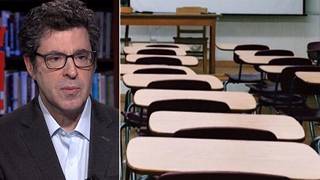
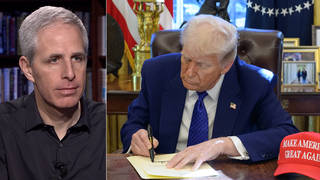
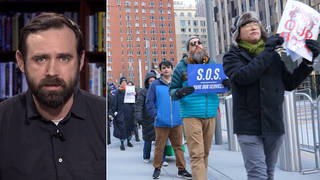

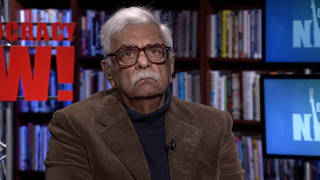
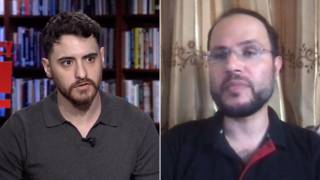
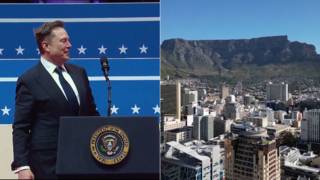



Media Options